Joos van Cleve's triptych of the Adoration of the Magi: a Flemish masterpiece in Genoa, restored
The painter Carlo Giuseppe Ratti had been rather peremptory when, in his Instruzione, a sort of eighteenth-century “tourist guide” to Liguria, he said, about the church of San Donato in Genoa, that the only notable panel, which is preserved there, is that of the Adoration of the Magi by Autor Fiammingo, in which we see with disproportionate anachronism St. Joseph with a rosary in his hand. Ratti, however, was completely right that the panel in the church of San Donato is a truly remarkable work: it is one of the most valuable preserved in the city, a triptych whose importance is also extraordinary because it contributed in a decisive way to making Flemish art known in Genoa. At the time (theInstruzione appeared in 1766 and a second edition came out in 1780) the name of the author of the Triptych of the Adoration of the Magi was not known, but today we know him well: he is Joos van Cleve (Cleve, c. 1485 - Antwerp, 1540/1541).
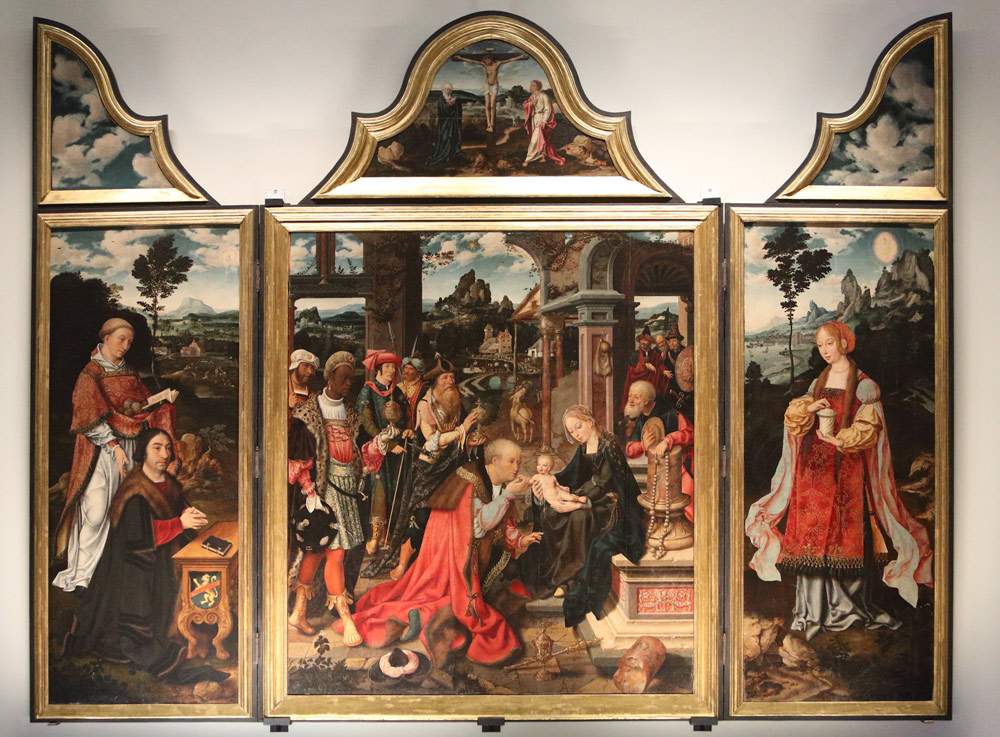 |
| Joos van Cleve, Triptych of the Adoration of the Magi (c. 1515; oil on panel; central panel, 156 x 138 cm; side panels, 162 x 67 cm; central cymatium, 51 x 96 cm; left cymatium, 52 x 46 cm; right cymatium, 54 x 45 cm; Genoa, San Donato). Photo by Maxfoto, Genoa. |
To present the painting we start from the events that have recently affected it. In particular, from a rather sad fact: the theft that the work suffered in 1974. Fortunately, Joos van Cleve’s triptych was luckier than many other works that were stolen and never found again, since it was found three months after its disappearance. However, the thieves had crudely dismembered its three panels, and to do so they had had to destroy the frame, which had been lost: as a result, the work was found with a damaged wooden support. Immediately subjected to restoration, however, the support continued to suffer (the boards had deformed to the point of leaving spaces of the length of about three millimeters between them), so that a new intervention was necessary, which was conducted by the expert hands of Antonio Silvestri, finished in recent weeks and presented to the public yesterday, Saturday, December 17, 2016, precisely in the church of San Donato. It is not one of those interventions that pull the works to shine or draw crowds: it is simply an intervention that was needed, as it was necessary to restore the optimal condition of the support of the triptych. A technical operation, in short, that involved the disassembly of the polyptych, the use of animal glues to glue the boards together (which had not been glued since the theft) and the insertion of a system of restraints to still leave a minimum freedom of movement to the support. But this was an important restoration for the preservation of the work, since there were fears for its survival, whereas now the renewed conditions can guarantee it a much longer and more peaceful life. And it was also an important restoration because it was made possible by a demonstration of love for art by a group of Genoese citizens, who came together in theGiano Cultural Association: the three hundred members agreed to donate their offerings and membership fees to fully fund the restoration. This is an admirable testimony of care for heritage, which will hopefully set an example for many others.
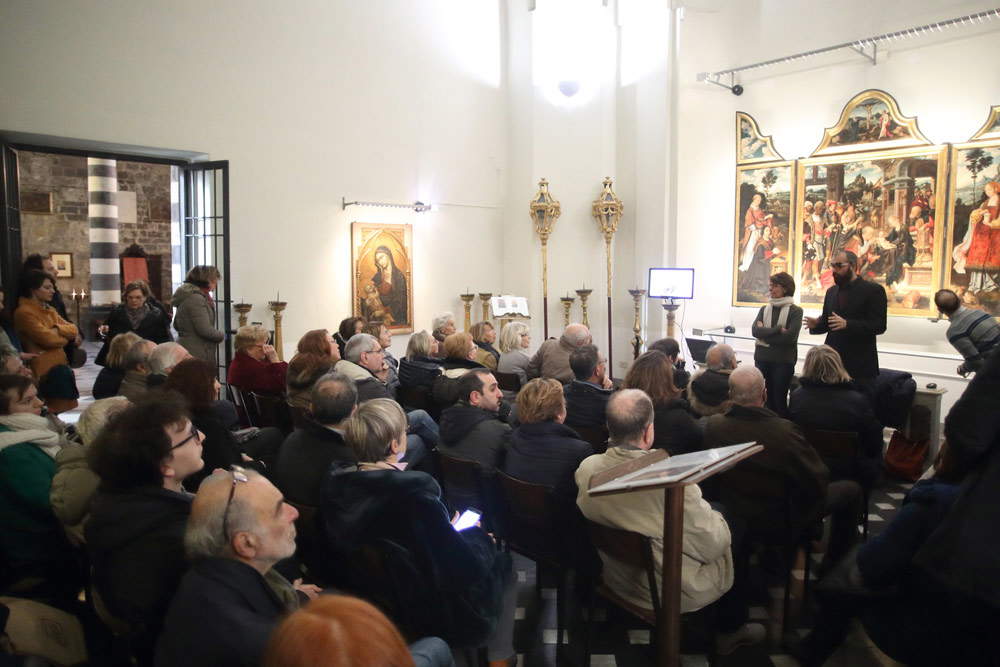
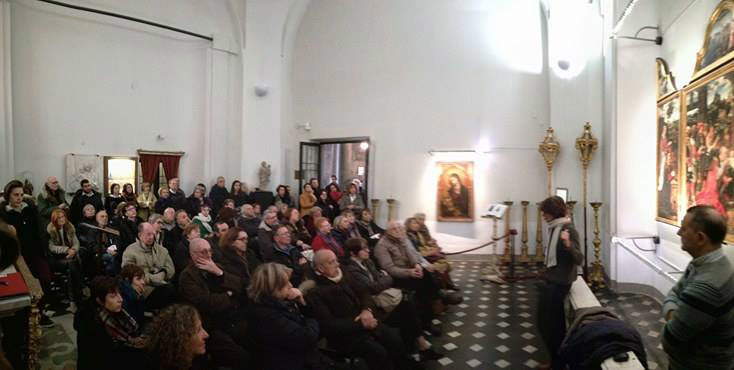
|
| Two moments of the restoration presentation. Photos by Maxfoto, Genoa (top) and by Giacomo Montanari (bottom). |
We must then consider that Joos van Cleve’s triptych is experiencing a particularly fortunate period: in 2015 the work celebrated its 500th anniversary, with the dedication of a day of celebrations and the release, in 2016, of a publication, edited by Gianluca Zanelli(Joos van Cleve. Il trittico di San Donato, SAGEP), which reconstructed the history of the precious painting. A story that begins roughly in 1515, or at any rate in the second decade of the 16th century. The patron was a nobleman, Stefano Raggio, who intended to endow the family chapel (later demolished) in the church of San Donato with an updated work of modern taste. The choice could only fall to one of the most up-to-date artists among those active in Genoa in the early 16th century: our own Joos van Cleve, who set to work to create his sumptuous triptych with theAdoration of the Magi in the central panel, the patron and Saints Stephen and Mary Magdalene in the side panels, and a Crucifixion in the central cymatium, while the right cymatium and in the left are intended to house the continuation of the sky that appears in the panels below.
So at least according to hypotheses, based on reconstructions: because no documents remain that can testify to a possible commission given by Raggio to the painter, there are no sources attesting to a trip by Joos van Cleve to Genoa, nor does any evidence survive of a possible (and plausible) stay by Raggio in Antwerp, a city to which the artist was linked and where he worked for a long time. Certainly the Raggios, active in commerce, had working relationships with Flanders. And the artist, for his part, had clients in Genoa. Although it was not easy to find the name of the author of that group of works, all Flemish and all evidently produced by the same hand, made for Ligurian patrons. It was the same hand that had painted a work preserved in the Wallraf-Richartz Museum in Cologne, a triptych with the Death of Mary, hence the name by which the author was conventionally known, namely the Master of the Death of Mary. Then, in 1894, the turning point: art historian Eduard Firmenich-Richartz managed to unearth, in the German panel, the monogram JB, which enabled him to trace the hitherto anonymous work back to our own Joos van Cleve (whose real name was Joos van der Beke). The discovery, initially welcomed not without some doubt, later allows the Genoese panels, including our Triptych of the Adoration of the Magi, to be attributed to Joos as well. There remains, however, the doubt of whether he stayed in Genoa: here, we can limit ourselves to saying that although no documentary evidence has survived, a stay in Liguria by Joos van Cleve would still not be ruled out.
However, even if Joos had not personally traveled to Genoa, this would not have prevented him from depicting Stefano Raggio in the left wing of the triptych. The Genoese nobleman, portrayed with vivid naturalism typical of Flemish art, is caught as he is about to pray on a kneeler marked with the family crest. He is introduced to the main scene by his eponymous saint, St. Stephen precisely, who carries in the fold of his liturgical robe some stones, the crude instrument of his martyrdom (the first in Christian history), while in the fifteenth-century landscape behind him, in the distance, the stoning scene takes place. Also typically Flemish is Raggio’s attire, with his long fur-trimmed cloak revealing the red sleeves of his dress. The landscape behind the protagonists continues with the same clarity, albeit with a logic that rules out the hypothesis that it was conceived united, until the right-hand sash, where a solitary Saint Mary Magdalene finds its place, which until not long ago was thought to be a tribute to Stefano Raggio’s late wife, Maria Maddalena Giustiniani, whose presence in the painting was wanted to be seen in the mandorla of light that appears in the sky above the saint. The hypothesis that would have such a mandorla symbolize the soul of the commissioner’s bride was already discarded a few years ago by the aforementioned Zanelli, who preferred to discern in the mandorla the apotheosis of the saint, carried to heaven by “minute angelic creatures barely sketched by the painter by means of very subtle touches of a soft pink hue softened by white.” It was believed, however, that the entire triptych was commissioned from the Flemish painter to honor the memory of Maria Magdalena Giustiniani and to decorate the place destined for her burial. And it is precisely to the year 1517, the date to which the marriage dates, that the commission given by Raggio to the painter could be fixed.
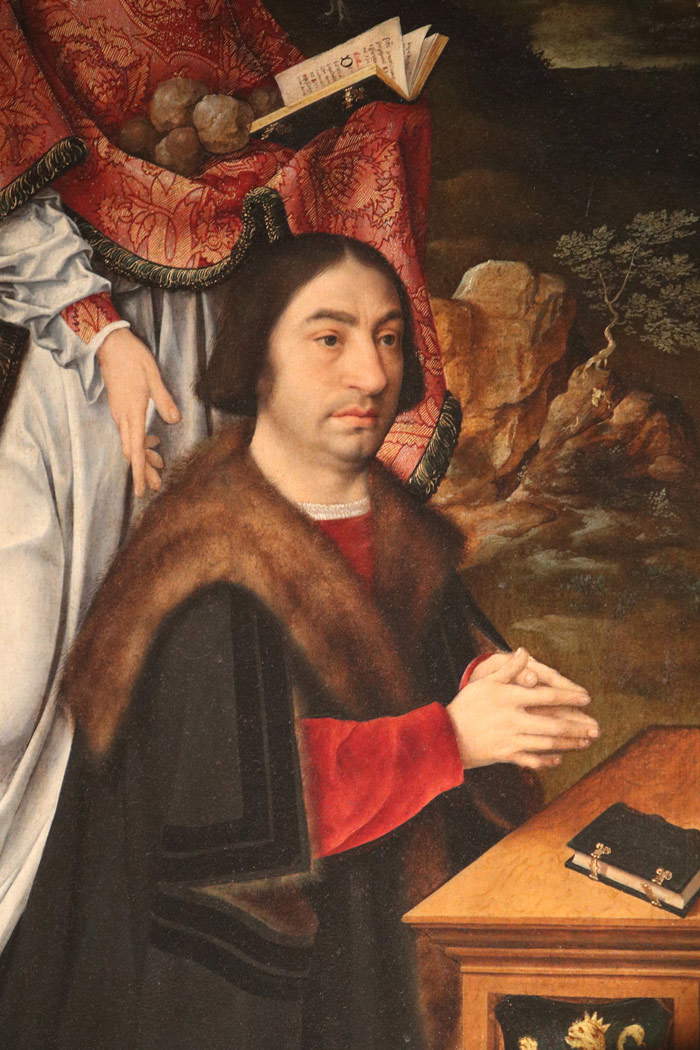
|
| Stefano Raggio’s portrait. Photo Maxfoto, Genoa. |
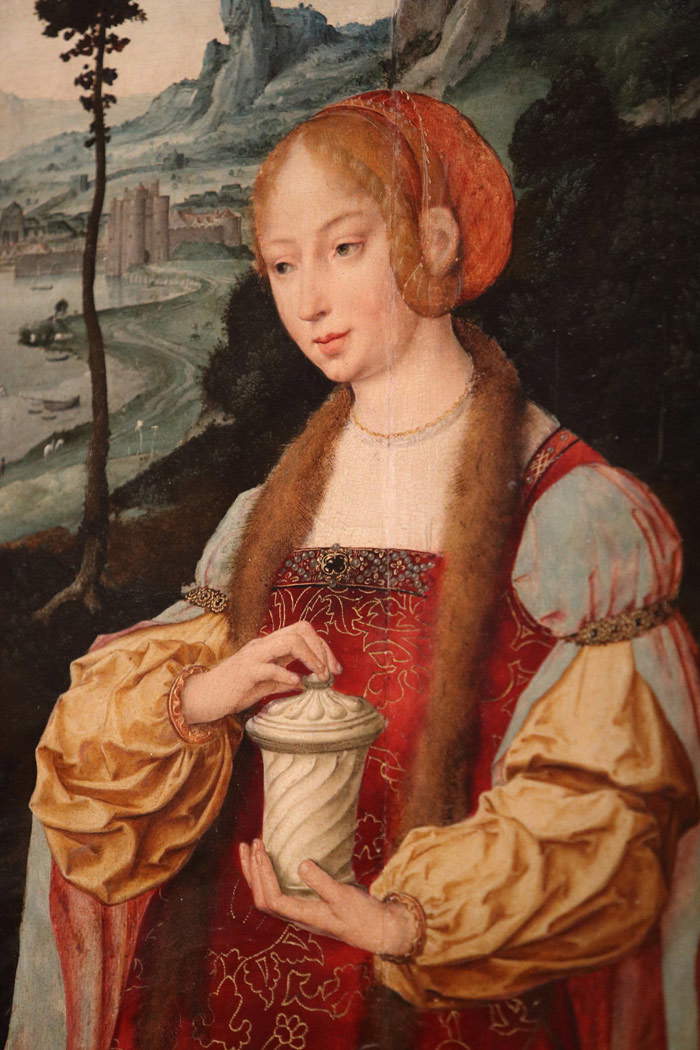
|
| Saint Mary Magdalene. Photo Maxfoto, Genoa. |
However, the hypothesis of a tribute to his wife was not compatible with an early dating of the polyptych, around 1515, so much so that it was definitively discarded by Maria Clelia Galassi in her recent contribution this year (as well as yesterday during the presentation of the restoration): in particular, Raggio’s bride would not have been called Magdalene by her second name, and the presence of the saint would therefore have to be reread in a religious and political key. According to Reformed theology (it was precisely in 1517 that Luther posted his own Ninety-Five Theses in Wittenberg, but the thought that would originate the Reformation was obviously already circulating) Mary Magdalene was, at the same time, the woman who had washed Christ’s feet, the redeemed prostitute, and the woman who had discovered Jesus’ empty tomb: after which, having fled to France, she would take refuge in the cave known as “de la sainte Baume,” where she would be elevated to heaven (hence the reason for the cave and the almond in the painting). But Magdalene was also a saint linked to the Habsburgs of Burgundy, a faction that Raggio supported and protected the Genoese nobleman himself: this would therefore also be a political allusion.
The crowded central scene, the one with theAdoration of the Magi, takes place under a ruined classical building, prey to climbing plants-a frequent setting for scenes of this kind. It is a riot of fabrics, fine velvets, sumptuous jewelry, rich decorations. It is pointless even to attempt to make a list of details to dwell on, such is the care Joos has taken in rendering these details. But let us still try to elecrate some of them. Beginning with the thick gold chain (with light reflecting off each link) of Balthazar, identified by the inscription “Balteser” that appears on the pyxis containing incense, which the black magician king brings as a gift to baby Jesus. Or, the leopard border of his cloak. The luxurious green brocade of the soldier who appears behind him, the one with the red headdress. And again, the decorations on the pyxis with which Gaspar, identified by the inscription “Jasper” on the edge of his very precious dark robe, gives the Child myrrh. The golden embroidery on the robe of Melchior, who kneels to kiss Jesus, having already deposited his own gift at his feet; thegold that Joos synthesizes in the pyx and scepter seen resting on the edge of the improvised marble throne on which the Virgin sits. The transparent veil that gently covers her blond hair but does not hide it from the eyes of the observer. The joyful smile of the Child Jesus. The natural nonchalance with which St. Joseph leans against a pillar, strictly behind his bride, almost aloof, to observe the scene. Holding the anachronistic rosary mentioned by Ratti. Also, the bag hanging on the pillar behind him, clear evidence of the everydayness that constituted another specific trait of Flemish figurative culture.

|
| The central scene with the Infant Jesus. Photo Maxfoto, Genoa. |
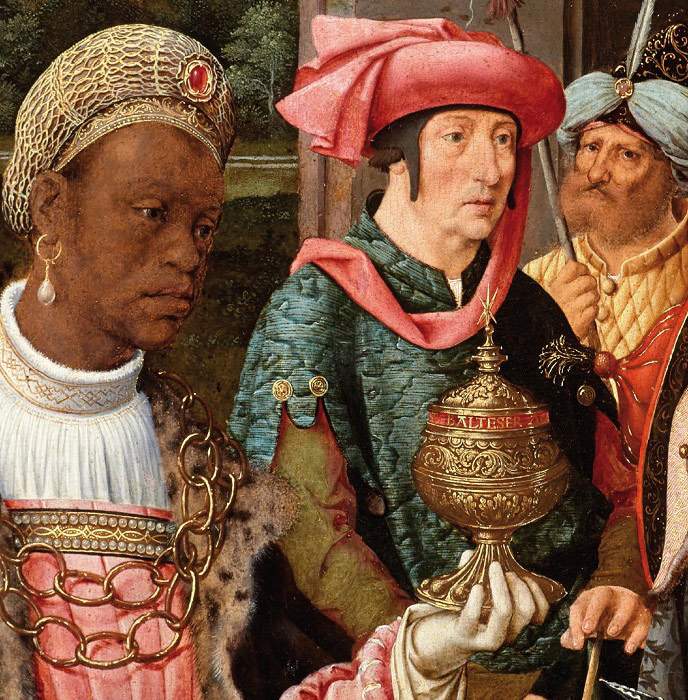
|
| The preciousness of the decorations |
And how can we fail to mention the landscape described so meticulously, with the procession of the magi winding along the roads leading from the sea to the temple, and which is studded with folk scenes, with villages teeming with characters in every busy activity? And then, behind Saint Mary Magdalene, abustling port city also appears, with boats plying the waters ahead: a clear reference to the city from which the patron came and to his industriousness. But that’s not all: this humanity appearing in the background was seen, on the one hand, as a further tribute to the industriousness of Stefano Raggio, as mentioned above who was active in commerce, and on the other hand, as a reference to the divine manifesting itself to every person who inhabits the earth.
For anyone who wants to see live all that has been described in this article, the way is only one: go to Genoa and visit the church of San Donato, a fundamental stop on the city’s “artistic route.” A route that, it must be reiterated, since yesterday is even more valuable thanks to the work done by the Janus Cultural Association: it is also thanks to the citizens’ demonstrations of attachment to their heritage that the awareness of that identity function is achieved, which, as one of the Association’s founding members, art historian Giacomo Montanari, told us, “allows us to work on many levels, from the cultural one to that of social inclusion, to reach the livability of a city that if known, then loved, becomes shared wealth to be maintained and preserved, but also a tool to reinvest in the perspective of a creative reuse of the historical artistic and monumental heritage.”
Reference bibliography
- Gianluca Zanelli (ed.), Joos van Cleve. The triptych of San Donato, SAGEP, 2016
- Gianluca Zanelli, Farida Simonetti (eds.), Joos van Cleve and Genoa. Around the Portrait of Stefano Raggio, exhibition catalog (Genoa, Galleria Nazionale di Palazzo Spinola, January 30-April 13, 2003), Maschietto Editore, 2003
- Carla Cavelli Traverso (ed.), Flemish Primitives in Liguria, Microart’s S.p.A., 2003
- Cecile Scailliérez, Joos van Cleve and Genoa, in Piero Boccaro, Clario Di Fabio (eds.), Flemish painting in Liguria: 14th-17th centuries, Cassa di Risparmio di Genova e Imperia, 1997
- John Oliver Hand, Martha Wolff, Early Netherlandish Painting, National Gallery of Art - Washington, 1986
Warning: the translation into English of the original Italian article was created using automatic tools. We undertake to review all articles, but we do not guarantee the total absence of inaccuracies in the translation due to the program. You can find the original by clicking on the ITA button. If you find any mistake,please contact us.



























